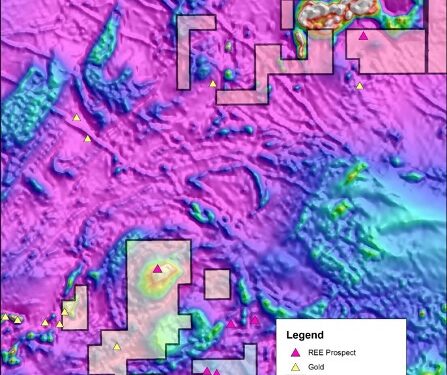Petratherm Limited (ASX: PTR) has been successful through a competitive bid process to be the preferred applicant for ELA 2022/00076 located in the Northern Gawler Craton of South Australia.
The tenement covers a 178 sq. km area over the central portion of a regionally extensive layered intrusive sequence known as the Muckanippie Anorthosite Complex which shows evidence of rare earth (REE) enrichment. The Muckanippie Complex is prospective for both primary REEs in the basement and secondary concentrations of Ionic Clay REEs in the overlying weathering profile.
In addition, PTR has received grant of an adjacent tenement area (EL 6815) covering an area of 80 sq. km over other portions of the Intrusive Complex. The licences collectively termed the “Muckanippie Project” make up an additional new REE exploration region, following encouraging REE results at PTR’s Comet Project Area 40 kilometres to the northeast.
A large circular magnetic anomaly (diameter > 4 kilometres) with an associated gravity anomaly forms the core of the Muckanippie Complex.
This central zone was drill tested by Dampier Mining (drill hole MW5) in 1978 with a single drillhole intersecting mafic intrusive rock from 32 metres to end of hole at 53 metres. Open file geochemical reports of the bottom three metre composite sample returned highly anomalous rare earth, cerium (Ce) of 1500 ppm, and related rare earth minerals niobium (Nb) 1350 ppm, and phosphate (P2O5) 4.25%.
Previous exploration in the region has not directly targeted REEs however limited geochemical assays of the light rare earths cerium (Ce) and lanthanum (La) has been undertaken in some instances along with petrological analysis of portions of the Muckanippie Complex. Further evidence for the areas fertility for REEs includes:
- SA Mines and Energy Department Drilling (1991) – RAB drill hole CAR 68 reported a bottom 4 metre composite sample of 400 ppm Ce, 163 ppm La and 85ppm Nb from 12 metres. The adjacent hole CAR 69 drilled 1 kilometre to the east (Figure 1) was described as a dolomite-phlogopite-microcline- tremolite rock of possible carbonatite affinity.
- Aztec Mining – Drill hole TCP1 (1994) testing a prominent magnetic feature of similar magnetic intensity to the central Muckanippie body intersected from 55-90 metres a magnetite-ilmenite rich rock containing on average 5% titanium. Later independent petrological analysis described the host rock as an ilmenite-apatite rock similar to Nelsonite found in Canada, which is noted for its high Ti and REEs. Other shallow vertical RAB drilling for gold in the region by Aztec (1996) included anomalous Ce and La in some drill holes including:
o MALB 030 – 4m @ 640ppm Ce, 300ppm La, from 20 metres
o MALB 066 – 4m @ 500ppm Ce, 180 ppm La from 8 metres
The Muckanippie Project includes the historic Malbooma Gold Mine (Figure 1) which was first reported in 1908 by Government geologists. Limited surface and shallow shaft mining of a quartz iron-oxide lode rock has occurred. No production records were recorded however mine spoil samples of the ore rock taken by Normandy Exploration in 1997 reported samples between 2 to 11 g/t Au. At Malbooma, the host Muckanippie Anorthosite is exceptionally high in aluminium with chemical analyses returning aluminium values ranging between 25-30% Al2O3. High aluminium and titanium is a regional characteristic of the intrusive complex and warrants further follow up work.
Granting of the tenement is likely to occur late in 2022 calendar period. PTR intends to undertake regional shallow air core drill traverses across the Muckanippie Complex exploring for horizons where REE enrichment may be occurring. PTR has in place an existing Native Title Mining Agreement with the Traditional Owners and as a result ground exploration could begin soon after grant.
For further information please visit: https://www.petratherm.com.au/












